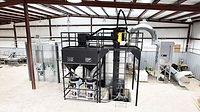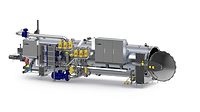By reducing food waste streams and examining creative, new ways to reuse and generate energy, these processors are able to save on electricity and water bills while simultaneously gaining the benefit of being seen as green-friendly by increasingly environmentally conscious consumers.
Sierra Nevada Brewing Company, based in Chico, CA, has a long history of being a sustainability leader and has made energy efficiency a cornerstone of its business model. “As our electrical grid became increasingly unreliable, we began to realize we needed to look for more reliable sources of electricity, and onsite generation was one way to accomplish that,” says Cheri Chastain, Sierra Nevada’s sustainability manager. “We are also privately held, so we have the freedom to invest in technologies other companies might not be able to invest in.”
Emerging technologies including cogeneration, industrial heat pumps, anaerobic digestion, and solar and wind power are among the most popular choices for food and beverage processors. These methods can be divided into generation, storage and conservation technologies.
“Solar, wind, cogeneration and biodigesters are generators, while fuel cells etc. are storage, meaning they need a generator to be charged,” says H.D. Boesch, chief technology officer of Mangan Renewables. “High-efficiency lighting and motor control are conservation measures. Mangan’s goal is to use as much conservation as possible in every customer’s facility and then use the best energy generator available.”
In fact, blending energy-efficiency technologies to achieve greater overall savings is a good practice, according to Harry Pettit, manager of systems and infrastructure engineering for Pepperidge Farm. The company’s Bloomfield, CT bakery facility includes a 1,200kW PPL fuel cell installed in 2008. The process of installing and implementing a 1MW solar array there is underway.
“If the fuel cell and solar panels are operating well, the plant will be generating 70 percent of its energy onsite,” Pettit says.
But Pepperidge Farms’ energy-reduction and reuse efforts don’t stop there. “The waste heat from the fuel cell stack, at 700°, is converted via a heat recovery steam generator [HRSG] to steam and hot water for the plant. The HRSG fulfills 99 percent of the plant’s steam and hot water needs, regardless of the level of output from the unit,” says Pettit.
Generating energy, generating profits
Cogeneration, solar, wind and biodigestion are aimed at solving the generation side of the energy-savings equation, but they do so in different ways and are suited to different plant environments and processes.
For instance, as Boesch points out, “food and beverage facilities typically have big roofs that can be used for solar without any impact on the usage of property, now and in the future. The connection to the existing electric system is seamless and doesn’t require equipment such as cogenerators.”
In some areas, wind power is an option as well. The Wind Program compiled a technical wind resource estimate in 2009 showing the land-based wind energy potential for the contiguous United States is a 10,500 gigawatt (GW) capacity at 80 meters and 12,000 GW capacity at 100-meter heights, assuming a capacity factor of at least 30 percent.
| Engineering energy savings |
|
Tom Fitzpatrick, power department manager for SSOE Group, shares his insights on energy-saving technologies from an engineering firm’s point of view. FE: Food manufacturers have many choices when it comes to energy-saving technology. How can they approach new projects with renewable energy in mind?Fitzpatrick: Implementing energy conservation is typically the cheapest way to lower energy costs. After that, it is a case-by-case study. Some things to think about include matching the electrical capacity of a system to the thermal load for cogeneration; minimizing the export of power; considering the use of any available waste fuels and waste heat; utilizing existing infrastructure as much as possible; and minimizing the physical distances to utility interconnections.
FE: What variables come into play when choosing energy-savings systems for the design of a new food or beverage facility? Does the facility have a year-round need for steam, hot water or chilled water? Is the manufacturing facility a 24/7 operation? Does the facility have any issues with waste disposal, or is the cost of disposal high? Is the manufacturer willing to sign a long-term energy contract with a developer? Typically, the payback for a cogeneration or renewable energy system is longer than the food manufacturer is willing to accept. However, many developers will accept a longer payback, but the manufacturer must be willing to sign a long-term agreement. Using a developer allows the manufacturer to use its capital on its core manufacturing business instead of on energy projects. Another consideration is whether the state or local utility has incentives for putting in renewable energy systems. For instance, the state of Ohio is considering a $0.0005/kWh incentive for certain renewable energy projects. It’s also important to have a sense for whether the local electric utility will work in a cooperative manner or an adversarial one. Also, the interconnection requirements differ from one utility to the next and can have a significant impact on the cost of the project, so get in touch with the local utility early in the process. Of course, solar requires the availability of a lot of land or large, flat roofs. Plus, structural steel changes may be needed to place solar panels on roofs that were not originally designed for the extra load. |
Pepperidge Farm plans to build a 1 to 3 MW wind system at its Willard, OH facility because, as Pettit says, the Department of Energy considers the Great Lakes region a prime wind energy area.
Of course, the high capital outlay for wind and solar installation, maintenance and infrastructure can be a deterrent to gaining approval for a new project. In that situation, it’s worth looking into a power purchase agreement (PPA), where a third party owns and operates the equipment—whether it’s a fuel cell, solar array or wind turbine—and sells power to the processor at a preferential rate.
“Campbell’s contracted with BnB Renewables to develop renewable projects at all of our facilities,” says Pettit. “BnB did the 6 MW solar installation at our Napoleon, OH facility. It will own and operate the equipment, and we will purchase the power at a rate below the current grid rate.”
One main benefit to solar and wind over other energy generators is the fuel for the system is unlimited and free. However, Boesch says the return on investment of solar projects varies from state to state and even within a state based on electricity cost. But “the financials of customers typically are based on a predicted five-year simple payback or better and 15 percent internal rate of return or more.
“We have installed solar systems on 39 Costco stores—typically 550kW—and its 1 million-sq.-ft. dry storage facility [3.5MW]. Typically, the solar offsets between 30 and 40 percent of electricity for a store.”
A facility’s geographic location and environment are considerations for solar and wind power, while the feasibility of biodigestion as an energy-generation technology depends more on what’s happening inside the plant.
Christian Kloser, managing director for AAT Biogas, says anaerobic digestion (AD) only makes sense for industries with a potential organic waste stream. The benefit, according to Kloser, comes from the combination of reducing a waste problem and generating electricity. “An AD plant is suitable for all kinds of processing with a lot of organic waste and high disposal costs,” he says. “Worldwide, a lot of installations are at breweries, potato processing facilities, vegetable processing facilities and slaughterhouses.”
One suitable organic waste stream is vegetable waste, according to Pettit. “The Campbell’s plant in Napoleon, OH sends its waste to a digester and receives all the power from the system,” he says. “Food waste from other facilities is also used by the system. Campbell’s has a PPA for this and purchases all the power from the system.”
Robert Shober, vice president of infrastructure energy and environmental programs for Campbell’s, says when the digester system is fully operational, and its electrical output is combined with the electricity from a solar panel project installed in 2011, the company’s Napoleon, OH thermal processing plant will be supplied with 40 percent of its electricity from renewable sources.
But developing an AD plant can be challenging, Kloser cautions. “You need to identify the substrate, and you need a solution for using the digestate sludge. It’s a perfect fertilizer, but you need the logistics, field and farmland to apply it.”
While alternative-energy technologies such as solar, wind and biodigestion address energy generation from a supply-side savings perspective, technology like industrial heat pumps and heat recovery units address demand-side energy use.
“Conventional ammonia refrigeration systems typically extract heat to produce a cooling effect and then reject the heat through condensers to the atmosphere,” says Sam Gladis, business director-heat pumps for Vilter Manufacturing LLC, a business unit of the Emerson Climate Technologies business segment. “Industrial ammonia heat pumps capture the extracted heat and convert it to usable heat.”
One obstacle to the successful implementation of heat pumps is pressure. “To convert the waste heat of ammonia—the most commonly used refrigerant in the food and beverage industry—to usable heat, a heat pump system needs to operate at pressures two to four times higher than conventional refrigeration pressures,” Gladis explains.
To overcome the high-pressure limitations of other compressor types, Vilter introduced a single-screw compressor design. “The internal forces of a single screw compressor are in balance,” says Gladis, “and as a result, the internal components of a single screw compressor are not subjected to the axial and radial thrust forces produced by other types of screw compressors, which readily enables its operation at higher pressures.”
Industrial heat pumps can be applied in food and beverage processing to satisfy hot water loads including sanitation, scalding, pasteurizing, blanching, bottle warming, produce washing and more.
A Midwestern lunch meat processing facility that operates an industrial heat pump as an alternative to a natural gas-fired direct contact hot water heater is one example of a successful implementation of heat pump technology. The application heats 170 GPM of 62°F water to 145°F by converting process refrigeration waste heat into usable heat with an average COP of 5.4, while delivering a 30 percent ROI, according to Gladis.
Cogeneration, or CHP, is another demand-side process that utilizes a heat engine or power station to convert excess heat from the production process to usable heat and electricity. In CHP, high-temperature heat drives a gas- or steam-powered turbine generator, with the excess low-temperature heat used for water or space heating. Trigeneration takes the process a step further, using additional excess heat for cooling, usually with an absorption chiller. Depending on the system’s construction, heating and cooling can take place alternately or concurrently.
According to Steve Edwards, principal consultant for energy consulting firm pitt&sherry, ensuring payback on a cogeneration project requires efficient design, efficient energy use and an understanding of a plant’s current overall energy costs. “There are installation costs that have economies of scale and plant costs that have economies of scale,” Edwards says. “Up to a point, larger plants do better economically. An unfortunate reality, but possibly a useful rule of thumb, is that plant sizes under 1 MW will struggle.”
Storage means savings
Energy generation is an important part of leveraging alternative energy technologies, but just as important is the ability to store that energy safely and inexpensively. Volatility in the energy sector has made in-house energy generation more attractive, but the storage side of the equation must make business sense as well.
Fuel cells convert hydrogen from natural gas or biogas plus oxygen to create clean electricity and heat. Though specific models vary, all fuel cells consist of a cathode, anode and electrolyte. Electrons are drawn from the anode to the cathode through an external circuit, producing direct current electricity. (The electrolyte allows charges to move between the cell’s two sides.) Installing a fuel cell system onsite with real-time monitoring capabilities allows plant managers to increase reliability and control power costs.
In 2008, Pepperidge Farm installed a Fuel Cell Energy DFC1500 unit that fulfills close to 50 percent of its Bloomfield, CT plant’s energy needs when functioning well, according to Pettit.
Sierra Nevada’s four hydrogen fuel cells, meanwhile, provided 55 percent of the brewery’s electricity in 2013, despite their being an older version. “Our fuel cells are the oldest operating Fuel Cell Energy fuel cells in the market, so a lot has changed since ours were installed. FCE learned a great deal about what not to do from our install and worked to improve its design,” says Chastain.
Bright future
Great strides in energy efficiency over the past several years have shown food and beverage manufacturers a business case can be made for onsite power generation and storage, waste reduction and other green energy initiatives.
So-called “closed loop” systems, which produce zero pollution while generating power exclusively through renewable technologies, are already in use at the Stuart Island Energy Initiative in Washington state and in Hempstead, NY. Could a food or beverage processor combine solar, wind, heat recovery, biodigestion and fuel cell technologies for a zero-pollution plant powered only by renewables in the near future? If current trends continue, it wouldn’t be surprising to see one named Food Engineering’s Sustainable Plant of the Year before long.
For more information:
Sam Gladis, sam.gladis@emerson.com,
414-486-5077, www.emersonclimate.com
H.D. Boesch, hdboesch@manganinc.com,
949-293-6102, www.manganinc.com
Christian Kloser, christian.kloser@aat-biogas.at,
+43 (0)5574 65190 18, www.aat-biogas.at
Tom Fitzpatrick, tom.fitzpatrick@ssoe.com,
567-218-2328, www.ssoe.com
Steve Edwards, info@pittsh.com.au,
+61 3 9682 5290, www.pittsh.au










